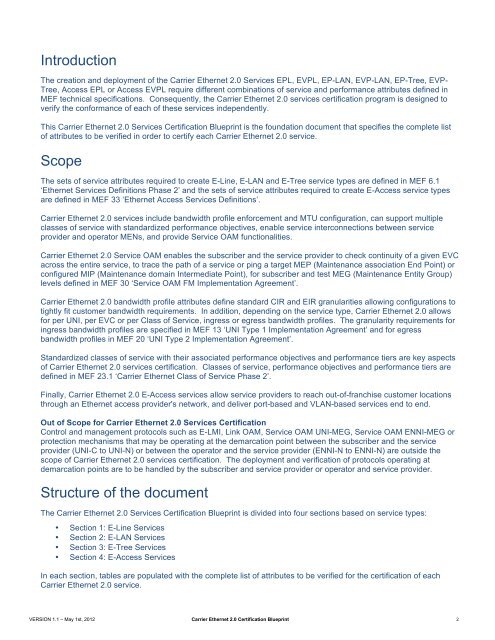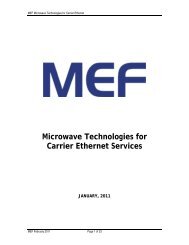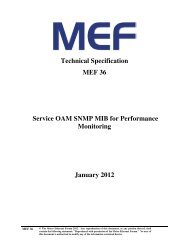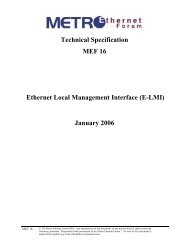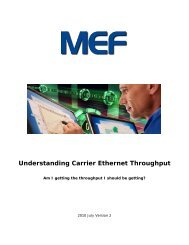Carrier Ethernet 2.0 Certification Blueprint - VERSION_1_1 - MEF
Carrier Ethernet 2.0 Certification Blueprint - VERSION_1_1 - MEF
Carrier Ethernet 2.0 Certification Blueprint - VERSION_1_1 - MEF
You also want an ePaper? Increase the reach of your titles
YUMPU automatically turns print PDFs into web optimized ePapers that Google loves.
Introduction<br />
The creation and deployment of the <strong>Carrier</strong> <strong>Ethernet</strong> <strong>2.0</strong> Services EPL, EVPL, EP-LAN, EVP-LAN, EP-Tree, EVP-<br />
Tree, Access EPL or Access EVPL require different combinations of service and performance attributes defined in<br />
<strong>MEF</strong> technical specifications. Consequently, the <strong>Carrier</strong> <strong>Ethernet</strong> <strong>2.0</strong> services certification program is designed to<br />
verify the conformance of each of these services independently.<br />
This <strong>Carrier</strong> <strong>Ethernet</strong> <strong>2.0</strong> Services <strong>Certification</strong> <strong>Blueprint</strong> is the foundation document that specifies the complete list<br />
of attributes to be verified in order to certify each <strong>Carrier</strong> <strong>Ethernet</strong> <strong>2.0</strong> service.<br />
Scope<br />
The sets of service attributes required to create E-Line, E-LAN and E-Tree service types are defined in <strong>MEF</strong> 6.1<br />
‘<strong>Ethernet</strong> Services Definitions Phase 2’ and the sets of service attributes required to create E-Access service types<br />
are defined in <strong>MEF</strong> 33 ‘<strong>Ethernet</strong> Access Services Definitions’.<br />
<strong>Carrier</strong> <strong>Ethernet</strong> <strong>2.0</strong> services include bandwidth profile enforcement and MTU configuration, can support multiple<br />
classes of service with standardized performance objectives, enable service interconnections between service<br />
provider and operator MENs, and provide Service OAM functionalities.<br />
<strong>Carrier</strong> <strong>Ethernet</strong> <strong>2.0</strong> Service OAM enables the subscriber and the service provider to check continuity of a given EVC<br />
across the entire service, to trace the path of a service or ping a target MEP (Maintenance association End Point) or<br />
configured MIP (Maintenance domain Intermediate Point), for subscriber and test MEG (Maintenance Entity Group)<br />
levels defined in <strong>MEF</strong> 30 ‘Service OAM FM Implementation Agreement’.<br />
<strong>Carrier</strong> <strong>Ethernet</strong> <strong>2.0</strong> bandwidth profile attributes define standard CIR and EIR granularities allowing configurations to<br />
tightly fit customer bandwidth requirements. In addition, depending on the service type, <strong>Carrier</strong> <strong>Ethernet</strong> <strong>2.0</strong> allows<br />
for per UNI, per EVC or per Class of Service, ingress or egress bandwidth profiles. The granularity requirements for<br />
ingress bandwidth profiles are specified in <strong>MEF</strong> 13 ‘UNI Type 1 Implementation Agreement’ and for egress<br />
bandwidth profiles in <strong>MEF</strong> 20 ‘UNI Type 2 Implementation Agreement’.<br />
Standardized classes of service with their associated performance objectives and performance tiers are key aspects<br />
of <strong>Carrier</strong> <strong>Ethernet</strong> <strong>2.0</strong> services certification. Classes of service, performance objectives and performance tiers are<br />
defined in <strong>MEF</strong> 23.1 ‘<strong>Carrier</strong> <strong>Ethernet</strong> Class of Service Phase 2’.<br />
Finally, <strong>Carrier</strong> <strong>Ethernet</strong> <strong>2.0</strong> E-Access services allow service providers to reach out-of-franchise customer locations<br />
through an <strong>Ethernet</strong> access provider's network, and deliver port-based and VLAN-based services end to end.<br />
Out of Scope for <strong>Carrier</strong> <strong>Ethernet</strong> <strong>2.0</strong> Services <strong>Certification</strong><br />
Control and management protocols such as E-LMI, Link OAM, Service OAM UNI-MEG, Service OAM ENNI-MEG or<br />
protection mechanisms that may be operating at the demarcation point between the subscriber and the service<br />
provider (UNI-C to UNI-N) or between the operator and the service provider (ENNI-N to ENNI-N) are outside the<br />
scope of <strong>Carrier</strong> <strong>Ethernet</strong> <strong>2.0</strong> services certification. The deployment and verification of protocols operating at<br />
demarcation points are to be handled by the subscriber and service provider or operator and service provider.<br />
Structure of the document<br />
The <strong>Carrier</strong> <strong>Ethernet</strong> <strong>2.0</strong> Services <strong>Certification</strong> <strong>Blueprint</strong> is divided into four sections based on service types:<br />
• Section 1: E-Line Services<br />
• Section 2: E-LAN Services<br />
• Section 3: E-Tree Services<br />
• Section 4: E-Access Services<br />
In each section, tables are populated with the complete list of attributes to be verified for the certification of each<br />
<strong>Carrier</strong> <strong>Ethernet</strong> <strong>2.0</strong> service.<br />
<strong>VERSION</strong> 1.1 – May 1st, 2012 <strong>Carrier</strong> <strong>Ethernet</strong> <strong>2.0</strong> <strong>Certification</strong> <strong>Blueprint</strong> 2


